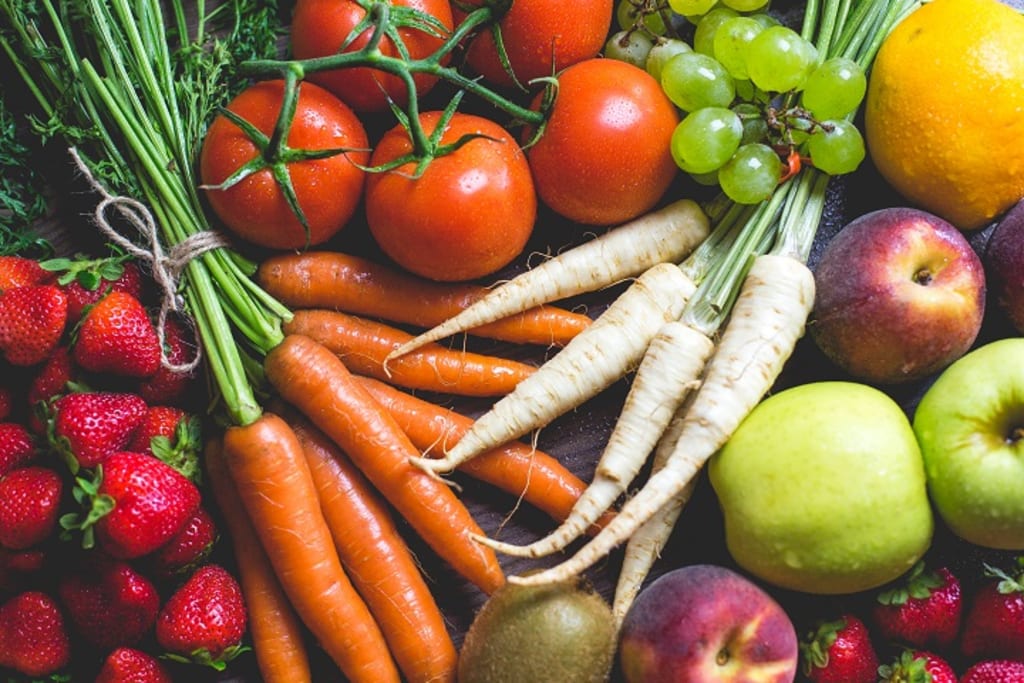How to Actually Implement an Anti-Inflammatory Diet
Elimination and Reintroduction

If you’re reading this, chances are you’ve spent a lot of time (or are about to spend a lot of time) researching inflammation in the body and anti-inflammatory foods. It’s a deep, dark rabbit hole of information, trust me. And while it’s very easy to find out what foods count as anti-inflammatory, it’s much more difficult to find a comprehensive guide on how to create an anti-inflammatory diet.
There are dozens of reasons for inflammation in the body, and it’s important to find a doctor you like and trust to help you decipher exactly what those reasons are. Whatever your reasons for adopting an anti-inflammatory diet are, just adding anti-inflammatory foods to your diet is only one side of the equation.
The other side, the side people most often miss, is making sure that your diet isn’t causing any of your inflammation. People often have food sensitives that they don’t know about, and these sensitivities can cause inflammation throughout the body. It’s important to note that sensitivities are different than allergies, being sensitive to a food isn’t going to create a dramatic reaction like hives or anaphylaxis, but they do cause your body to create antibodies to the food(s) it doesn’t like. Those antibodies result in widespread inflammation.
“But how do I do that?”
It’s actually very simple. You can have some really expensive blood testing done, that usually isn’t covered by insurance and some doctors question the validity of. Or you can remove foods from your diet and see if any of your pain or other symptoms subside. Okay, it’s a bit more involved than that, but that’s the gist.
In practice, you must eliminate foods (usually food groups*) from your diet for at least six weeks. This is because it takes a minimum of six weeks for your body to flush out those antibodies that it already has created. I recommend a full eight weeks. This ensures that those antibodies are gone and you have a clean slate to start with. Many people do feel worse during the beginning of this elimination period, around weeks two or three. This is normal, and to be honest, it sucks, but if you stick with it you should be feeling a lot better by week eight.
*I say food groups because things like dairy or gluten are found in a LOT of foods. Just eliminating bread won’t eliminate all gluten from your diet if you eat pasta, and eliminating milk won’t eliminate dairy if you’re still eating cheese. You get the idea.
Then you slowly reintroduce the eliminated foods back into your diet. I really do mean slowly. If you eliminate dairy products, start by reintroducing milk alone, don’t go on an all-day binge of milk and cheese and ice cream. If the reintroduced food was causing inflammation you will notice that your symptoms flare. A flare can present in many ways, for me it means increased pain and fatigue, for other it can mean full-body malaise, or just feeling flu-ish. Pay attention to your body, and if you think you’re feeling worse, you’re probably experiencing a flare. If you do flare you should continue to eliminate that food from your diet. If it was not causing inflammation, there should be no change in how you’re feeling, and it is okay to keep that food in your diet. You continue to do this one by one with the foods you eliminated, and eventually, you’ll have a diet that works for you.
That’s a lot of information, and a good outline to follow, but here’s a more closely guided version.
Step One: Eliminate Foods
Most professionals agree that dairy, gluten, and sugar cause the most sensitivities, so it's best to start with them. You can cut all three groups out at once, or you can cut them out one at a time, whatever works for you. If you’re racking your brain trying to figure out what to eat, a Paleo diet works pretty well here. Basically, you eat meat and veggies. If you’re vegetarian… well, stick to the veggies.
In this case, sugar is referring to processed sugars. Basically, anything pre-made, or anything containing white sugar. Fruits are fine, although some people cut those as well. I personally cut out dairy, gluten, and processed sugar on my first round of eliminations; fruit and caffeine on my second round; and vegetables and spices on my third.
If/when you cut out fruits and/or vegetables, make sure you introduce them one by one. Some people find that individual fruits or vegetables cause sensitivities, and not all related ones do. So, take it slow and makes sure you do it right. For each round of eliminations, wait at least six weeks before moving to step two. I personally recommend waiting for eight weeks.
Step Two: Reintroduction
Now you’ve waited eight weeks. You can finally eat those delicious foods again. Hopefully, you’re feeling better than you were eight weeks ago. (Tip: If you are feeling significantly better after eliminating foods, there is a good chance that some of them were causing inflammation.) But if you’re not, that just indicates you don’t have a sensitivity to any of the foods you eliminated.
Let’s say you eliminated dairy. Start by picking ONE dairy item, for this example milk, and add it back into your diet. Try a glass at breakfast, or maybe use milk in a smoothie. If you notice any flaring symptoms STOP EATING OR DRINKING the food immediately. You have found an item that you have a sensitivity to. Remove it from your diet, or if it can not be completely removed, limit it.
Wait for your flare to subside, this is usually a day or two, and try the next item. Let’s say you try yogurt next. If you experience another flare, remove that item from your diet too. If you do not experience a flare, you have found an item you can keep eating.
I personally found that I am mildly sensitive to milk, but not to other dairy products. So, I still use milk when baking or cooking, but I won’t drink a glass of milk at breakfast, or add it as the base for smoothies. I eat other dairy products (butter, cheese, yogurt, ice cream) as I please.
I may be a fluke when it comes to dairy, as many people experience sensitives to all dairy products. But that’s why I recommend trying items one by one. Dairy products are all made differently, your sensitivity to one may not transfer to another. And do remember that a dairy sensitivity is not the same as being lactose intolerant. If you are lactose intolerant, you probably already know it, and you will experience symptoms to all dairy products. Don’t put yourself (or your loved ones) through that torture by trying all the different dairy products because some woman on the internet told you to.
Similarly, gluten is something that is an all or nothing item. Any foods made from wheat, rye, or barley contain gluten. This includes breads, pastas, cereals, crackers, and beer. Trying every variety of those foods is pointless because gluten is found in all of them. And again, there is a difference between a gluten sensitivity and an intolerance to gluten, called Celiac disease. Celiac disease is an autoimmune disorder in which consuming gluten causes physical damage to the small intestine. Sensitivities do not cause permanent damage, they just create inflammation. If you suspect you have Celiac disease, talk to your doctor, there’s a pretty accurate blood test. Luckily, there are a lot of gluten-free options for typically gluten-full foods. So, you may find that eliminating gluten completely is not as hard as it first seems.
For things like fruits or vegetables, it’s important to try items one by one. You may find you’re sensitive to pears or kale, but not related fruits or vegetables. Or you could find you’re sensitive to all citrus fruits. Your results are specific to you, so trying each food on its own ensure that you’ll have the widest variety in your diet, without that pesky inflammation.
There is one thing on the vegetable subject that I’d like to note, pertaining to nightshade vegetables. If you’ve heard of this group of veggies, which includes peppers, tomatoes, potatoes, and eggplants, you’ve probably been told to avoid them. I’m calling that bluff. I’ve had doctors tell me all about the horrors of nightshades (mainly, that they were causing all or most of my pain), and I’ve talked to other doctors and other professionals about them as well. It’s an old wives’ tale. Nightshade vegetables are not any more likely to cause you pain than any other vegetable. Could you still have a sensitivity to one, some, or even all of them? Yes. Should you just blatantly avoid them because they’re demon-vegetables? No. If you’re that worried about how they’re affecting your symptoms, then test them. Eliminate them for eight weeks, and then reintroduce them and see how you feel. I’m betting you’ll feel way better because French fries are back in your life.
Oh, and if you know you’re allergic to a food or food group…don’t try it. I feel like that’s common knowledge, but I’m going to tell you anyway. I’m allergic to fish. Fish are great for you and are usually regarded as natural anti-inflammatory foods. Did I try reintroducing fish to my diet? No, because anaphylaxis is not fun. DO NOT EXPERIMENT WITH FOODS THAT YOU ARE ALLERGIC TO. JUST DON’T.
After all of this, you should have a diet that avoids foods that cause you inflammation. Pair this information with naturally anti-inflammatory foods, like fish, berries, nuts, ginger, and turmeric and you should be feeling a lot better.
After sharing all this with you, I feel that I owe you one more personal note. This isn’t going to work for everyone, and I’m one of those people. I did everything right. I completely cut foods out. I waited eight weeks before ever reintroducing them to my diet. I loaded my diet with additional anti-inflammatory foods. But my symptoms didn’t go away, and they didn’t get better. And that’s okay. All that means is that my inflammation isn’t coming from my food. And I am better off knowing that. Because I spent the time to ensure that my diet isn’t causing any (or all) of my pain, my doctor and I can focus on finding the true cause of it. Had my diet been causing any bit of my pain, it would have meant that even a correct diagnosis of my additional autoimmune issues wouldn’t have eliminated all of my pain. I would have always been searching for that missing piece.
I truly hope this helps you or at least gives you a place to start. I’m always up for discussing this stuff, so if you have questions or want to yell at me find me on Twitter.
About the Creator
Erin Foster
History and English student. I have a lot of opinions and I swear a lot, come join me on twitter @ErinLynn917.
Enjoyed the story? Support the Creator.
Subscribe for free to receive all their stories in your feed. You could also pledge your support or give them a one-off tip, letting them know you appreciate their work.






Comments
There are no comments for this story
Be the first to respond and start the conversation.